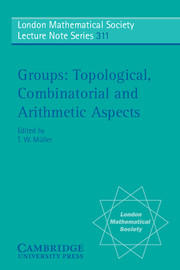Book contents
- Frontmatter
- Contents
- List of authors and participants
- Preface
- 1 Reductive groups as metric spaces
- 2 Finiteness properties of groups acting on twin buildings
- 3 Higher finiteness properties of S-arithmetic groups in the function field case I
- 4 Controlled topology and group actions
- 5 Finiteness properties of soluble S-arithmetic groups – A survey
- 6 Topology in permutation groups
- 7 Euler characteristics of discrete groups
- 8 Intersections of Magnus subgroups of one-relator groups
- 9 A minimality property of certain branch groups
- 10 Lattices with non-integral character
- 11 Some applications of probability in group theory
- 12 Parity patterns in Hecke groups and Fermat primes
- 13 Automorphisms of the binary tree: state-closed subgroups and dynamics of 1/2-endomorphisms
- 14 The mapping class group of the twice punctured torus
- 15 Kac–Moody groups: split and relative theories. Lattices
- 16 On the finite images of infinite groups
- 17 Pseudo-finite generalized triangle groups
13 - Automorphisms of the binary tree: state-closed subgroups and dynamics of 1/2-endomorphisms
Published online by Cambridge University Press: 04 November 2009
- Frontmatter
- Contents
- List of authors and participants
- Preface
- 1 Reductive groups as metric spaces
- 2 Finiteness properties of groups acting on twin buildings
- 3 Higher finiteness properties of S-arithmetic groups in the function field case I
- 4 Controlled topology and group actions
- 5 Finiteness properties of soluble S-arithmetic groups – A survey
- 6 Topology in permutation groups
- 7 Euler characteristics of discrete groups
- 8 Intersections of Magnus subgroups of one-relator groups
- 9 A minimality property of certain branch groups
- 10 Lattices with non-integral character
- 11 Some applications of probability in group theory
- 12 Parity patterns in Hecke groups and Fermat primes
- 13 Automorphisms of the binary tree: state-closed subgroups and dynamics of 1/2-endomorphisms
- 14 The mapping class group of the twice punctured torus
- 15 Kac–Moody groups: split and relative theories. Lattices
- 16 On the finite images of infinite groups
- 17 Pseudo-finite generalized triangle groups
Summary
Introduction
Automorphisms of regular 1-rooted trees of finite valency have been the subject of vigorous investigations in recent years as a source of remarkable groups which reflect the recursiveness of these trees (see [S1], [G2]). It is not surprising that the recursiveness could be interpreted in terms of automata. Indeed, the automorphisms of the tree have a natural interpretation as input-output automata where the states, finite or infinite in number, are themselves automorphisms of the tree. On the other hand input-output automata having the same input and output alphabets can be seen as endomorphisms of a 1-rooted tree indexed by finite sequences from this alphabet. It is to be noted that the set of automorphisms having a finite number of states and thus corresponding to finite automata, form an enumerable group called the group of finite-state automorphisms. The calculation of the product of two automorphisms of the tree involve calculating products between their states which are not necessarily elements of the group generated by the two automorphisms. In order to remain within the same domain of calculation we have defined a group G as state-closed provided the states of its elements are also elements of G [S2]. Among the outstanding examples of state-closed groups are the classes of self-reproducing (fractal-like) groups constructed in [G1, GS, BSV] which are actually generated by automorphisms with finite number of states, or equivalently, generated by finite automata.
Information
- Type
- Chapter
- Information
- GroupsTopological, Combinatorial and Arithmetic Aspects, pp. 375 - 404Publisher: Cambridge University PressPrint publication year: 2004
Accessibility standard: Unknown
Why this information is here
This section outlines the accessibility features of this content - including support for screen readers, full keyboard navigation and high-contrast display options. This may not be relevant for you.Accessibility Information
- 19
- Cited by
